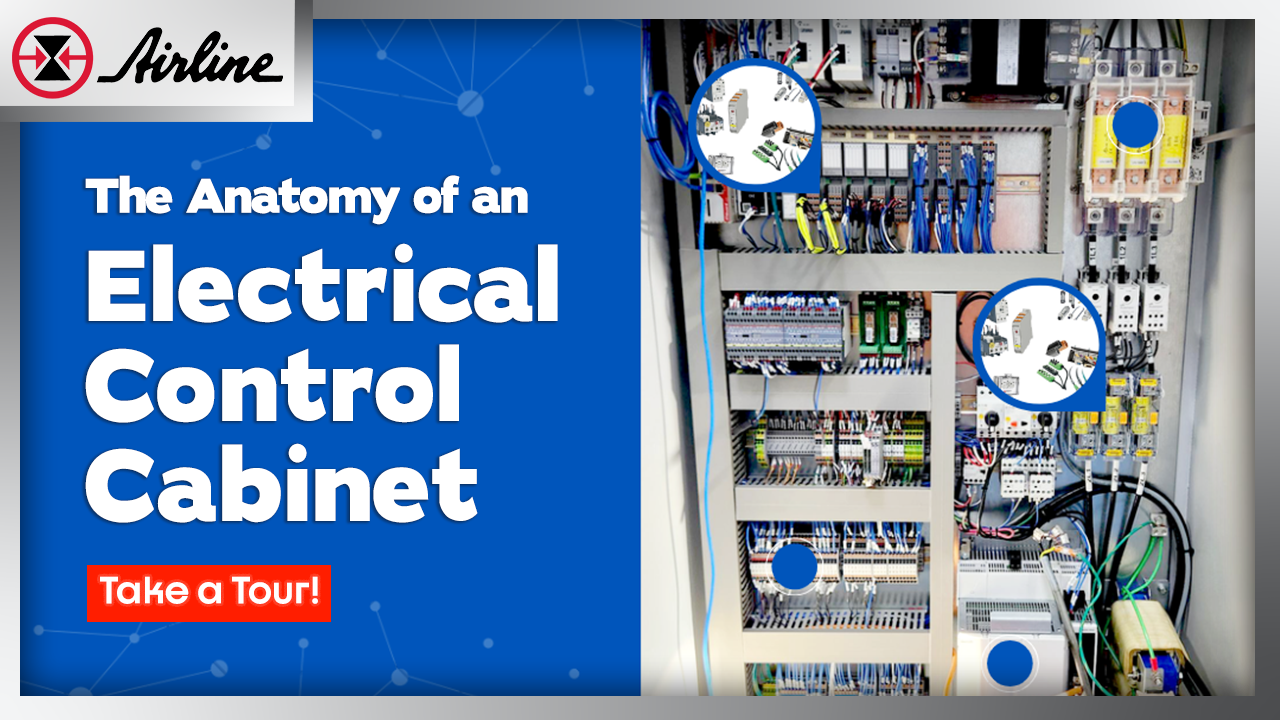An electrical control cabinet might look like a maze of cables and devices to the untrained eye, but each component plays a vital role in keeping machines and processes running smoothly. Whether you're an engineer or technician, understanding the inner workings of an electrical control cabinet is a necessary skill for all types of industrial applications.
Let’s take a journey through the anatomy of an electrical control cabinet and learn about the different products that make up these essential systems.
In this post:
What's Inside an Electrical Control Cabinet? | Control Cabinet Products | How to Shop for Control Cabinet Products | Layout of an Electrical Control Cabinet | Additional Resources
Shop Electrical Control Components
What's Inside an Electrical Control Cabinet?
Take a look inside an electrical control cabinet that our team specified, stocked, and supported. Hover over each dot to explore different components like power supplies, circuit breakers, terminal blocks, controllers, safety relays, and much more, along with the vendors that supply these products. After taking a tour, keep reading to learn more about each type of component.
Power and Safety Components
Power Supply Units: These devices, often produced by brands like Eaton, Phoenix, and Omron, ensure a steady and safe supply of power to all the control devices. Most control cabinets feature a 24 VDC power supply, allowing for safe operation across the control system.
Transformers: You'll often see transformers from brands such as Hammond and ABB. These transformers step down high voltage from 480 volts to something more manageable, powering different control circuits.
Disconnect Switches: A usable disconnect switch, like the ones from Eaton or ABB, provides an easy way to safely power down the cabinet for maintenance or emergencies. These switches are a critical safety component.
Fuse Holders and Fuses: Supplemental fuse holders, typically from Eaton, ensure that each component has the necessary overcurrent protection to prevent system failure.
Power Distribution Blocks: Power distribution blocks are connectors that split a primary power feed into multiple secondary feeds. This division allows a single power source to energize multiple devices or circuits seamlessly, eliminating the need for excessive wiring and maintaining an organized cabinet layout.
Control and Automation Components
Programmable Logic Controllers (PLCs): The PLC is the brain of the cabinet. Popular PLCs such as Phoenix's PLCnext system are used to control the processes and operations running through the cabinet, offering remote I/O capabilities and integrating seamlessly with other devices.
Safety PLCs: Safety PLCs, like ABB's Pluto series, help ensure safety by handling the signals redundantly, allowing for the safe monitoring of key parameters, such as pressure levels.
Servo Drives: Servo drives are used to regulate the speed, position, and torque of servo motors with high precision, utilizing feedback signals for closed-loop control to ensure optimal performance, high dynamic response, and accurate positioning in automation systems.
CTRL-X Core Processor: The CTRL-X Core Processor is an advanced industrial control system that offers powerful processing capabilities for automation tasks. It provides a modular, flexible platform for edge computing and real-time control, supporting a wide range of industrial protocols and allowing seamless integration with other control systems. The CTRL-X Core Processor is designed to enhance system performance, reduce latency, and support Industry 4.0 applications, enabling intelligent decision-making and optimized process control.
Enclosure and Cooling
Cabinet Enclosure: The enclosure protects all the components inside from dust, moisture, and other external factors. It also ensures safety for personnel by keeping high-voltage components contained.
Cooling System: Proper cooling is essential to prevent overheating, especially in cabinets with high-power devices. Fans or air conditioning units are typically installed to maintain a stable internal temperature.
Connectivity and Management Components
Terminal Blocks: These products from trusted brands like Eaton and Phoenix provide a convenient connection point for wiring, helping to organize and manage the many connections within the cabinet.
Cable Management: Cable management solutions from icotek, such as ducting and ties, are used to keep wiring organized and prevent clutter, which is important for both safety and ease of maintenance.
These components, among others, combine to create a functional and effective electrical control cabinet that drives successful operations across different industries.
How to Shop for Control Cabinet Products
Shopping for control cabinet products can be an overwhelming task due to the number of different brands and options available. Here are a few tips to make it easier:
Understand Your Needs: Identify the power requirements, I/O configurations, and safety considerations that match your specific project.
Choose Reliable Brands: Look for reputable manufacturers like Phoenix, Eaton, Omron, and ABB, which are well-known for producing high-quality products.
Compatibility Check: Make sure all your components are compatible with each other, especially if integrating new equipment into existing setups.
Plan for Safety: Always prioritize safety components such as fuse holders, disconnect switches, and safety PLCs.
Shop Electrical Control Components
How It Works: Understanding the Layout of an Electrical Control Cabinet
Control cabinet layout is more than just putting components in a box—it requires strategic planning to optimize efficiency and safety. Here are some tips for the layout of an electrical control cabinet:
Power Distribution: To separate power from control, keep power components, such as the power supply, transformers, and power distribution blocks, on one side of the cabinet.
Logical Flow: Arrange components logically to reflect the workflow—this means input devices, controllers (like PLCs), and then output devices.
Safety First: Place disconnect switches and safety devices in easily accessible areas for quick shut-down in case of an emergency.
Consider Airflow: Good ventilation or cooling is essential to prevent overheating, especially for cabinets that house high-power devices.
Explore Electrical Control Products Today!
Interested in enhancing your electrical control systems? Understanding what goes into a control cabinet is just the beginning.
Explore a wide variety of high-quality control cabinet products from trusted manufacturers and get the components you need to build or maintain your electrical control systems.
Additional Resources
- Contact Us
- Eaton
- Phoenix
- Omron
- Hammond
- ABB
- Phoenix's PLCnext system
- CTRL-X Core Processor
- fuse holders, disconnect switches, and safety PLCs.
- icotek
Contact Us!
Ask your Airline Rep. or contact us for assistance with ordering or customizing an order.
- 800-999-7378








Leave Comment